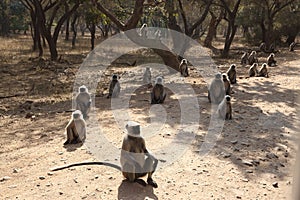- Price: 1$
- Size Facebook: 1702 x 630 px
- Size Twitter: 1500 x 500 px
- Size LinkedIn: 1128 x 191 px
More Facebook, Twitter and LinkedIn Cover Photos
Cover photo info
- Photo title: gray hanuman langurs. begging monkeyes. the beggers of sariska tiger reserve alwar district, rajasthan, India.
- Author: Chennaihussainpictures
- Cover photo description:
- the beggars of sariska tiger reserve alwar district, rajasthan, India. its a common sight in the jungle of alwar, hundreds of the Bengal sacred langur or the Hanuman langur as they are called waiting for people traveling to the village into the jungle to throw food towards them. as they wait, it looks like the beggars in India commonly wait in front of the temples, so human like so natural. The northern plains gray langur also known as the Bengal sacred langur and Hanuman langur, is a species of primate in the family Cercopithecidae. The fur of adults is mostly light colored, with darker fur on the back and limbs, and the face, ears, hands and feet are all black. Sariska National Park is a tiger reserve in Alwar district, Rajasthan, India. It stretches over an area of 881 km comprising scrub-thorn arid forests, dry deciduous forests, grasslands. The landscape of Sariska Wildlife Sanctuary is dominated by a series of rising and falling hills. The land is covered by dry deciduous trees, such as Dhok, Ber, Khair, Surwal Tendu and Goria. Sariska National Park is a natural habitat to a large population and wide variety of wild animals including Tigers, Wild Boars, Jackals, Hyenas, Leopards, Wild Dogs, Nilgai, Jungle Cats, Chital, Chausingha, Sambar and Langurs. The northern plains gray langur eats primarily fruits and leaves. It is able to survive on mature leaves, which is a key to its ability to survive throughout the dry season. It also eats seeds, flowers, buds, bark and insects, including caterpillars.You may have the best intentions when you want to share your trail mix with a critter in a park but feeding wildlife is dangerous. Human foods are not healthy for wild animals. Animals that eat our snacks can get full off the wrong foods and stop eating the nutrients they need to survive. They can stop hunting, foraging, or scavenging as they would naturally. They literally want to get chips or die trying.Depending on humans for food is called food conditioning. Food conditioning is dangerous for animals because it can lead to serious consequences like getting sick, starving, or even having to be killed if they become too aggressive. Animals can lose their fear of people when they get used to eating our food. They may beg, steal, or even rip into backpack or tent if you don’t give it to them. Because they approach, people might think the animals are tame like our pets at home, but they are still wild creatures. If the animal feels threatened for any reason, it could bite, kick, charge, or attack you. When visitors intentionally or unintentionally feed wildlife, it has negative effects on the wildlife. Whether visitors offer scraps and crumbs to birds and other wildlife or simply forget to secure their trash, risks to wildlife from eating human food are great. Some of the dangers to wildlife include shorter lives and poor nourishment. The best way for wildlife to have a healthy diet and live healthy lives is to hunt, forage, or scavenge for food as they would naturally.
- Image ID:315298760
- Views:0
- Downloads:0














